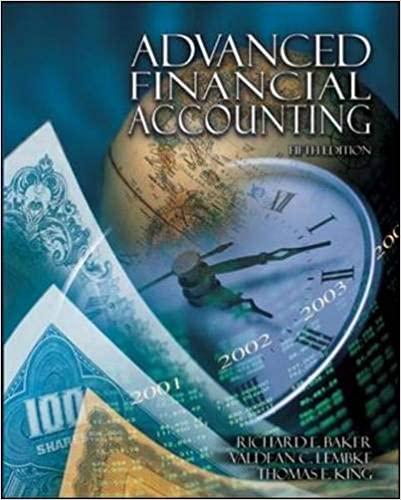Select the correct answer for each of the following questions. 1. How would the retained earnings of
Question:
Select the correct answer for each of the following questions.
1. How would the retained earnings of a subsidiary acquired in a business combination usually be treated in a consolidated balance sheet prepared immediately after the acquisition?
a. Excluded for both a purchase and a pooling of interests.
b. Excluded for a pooling of interests but included for a purchase.
c. Included for both a purchase and a pooling of interests.
d. Included for a pooling of interests but excluded for a purchase.
2. Consolidated financial statements are typically prepared when one company has:
a. Accounted for its investment in another company by the equity method.
b. Accounted for its investment in another company by the cost method.
c. Significant influence over the operating and financial policies of another company.
d. The controlling financial interest in another company.
3. Aaron Inc. owns 80 percent of the outstanding stock of Belle Inc. Compare the consolidated net earnings of Aaron and Belle \((\mathrm{X})\) and Aaron's net earnings if it does not consolidate Belle \((\mathrm{Y})\).
a. \(\mathrm{X}\) is greater than \(\mathrm{Y}\).
b. \(\mathrm{X}\) is equal to \(\mathrm{Y}\).
c. \(\mathrm{X}\) is less than \(\mathrm{Y}\).
d. Cannot be determined.
4. On October 1, X Company acquired for cash all the outstanding common stock of Y Company. Both companies have a December 31 year-end and have been in business for many years. Consolidated net income for the year ended December 31 should include net income of:
a. X Company for three months and \(\mathrm{Y}\) Company for three months.
b. X Company for 12 months and \(\mathrm{Y}\) Company for 3 months.
c. X Company for 12 months and \(\mathrm{Y}\) Company for 12 months.
d. X Company for 12 months, but no income from \(\mathrm{Y}\) Company until \(\mathrm{Y}\) Company distributes a dividend.
5. A subsidiary may be acquired by issuing common stock in a pooling of interests transaction or by paying cash in a purchase transaction. Regardless of which of these two approaches is used to effect the combination, which of the following items would be reported in the consolidated financial statements at the same amount?
a. Noncontrolling interest.
b. Goodwill.
c. Retained earnings.
d. Capital stock.
6. Ownership of 51 percent of the outstanding voting stock of a company would usually result in:
a. The use of the cost method.
b. The use of the lower-of-cost-or-market method.
c. A pooling of interests.
d. A consolidation.
Step by Step Answer:

Advanced Financial Accounting
ISBN: 9780072444124
5th Edition
Authors: Richard E. Baker, Valdean C. Lembke, Thomas E. King





